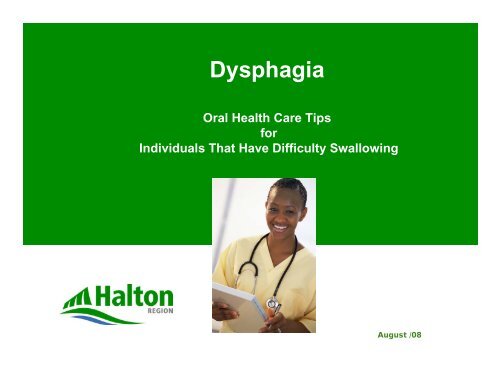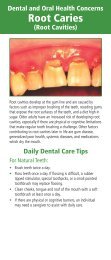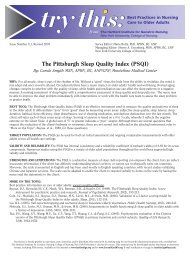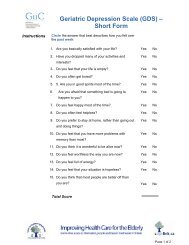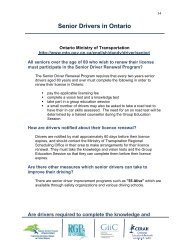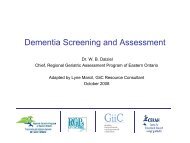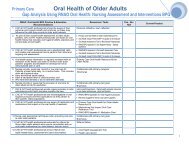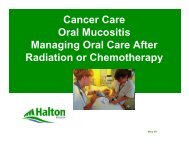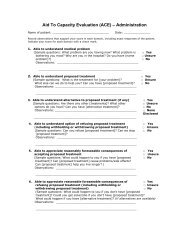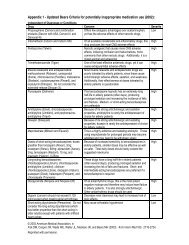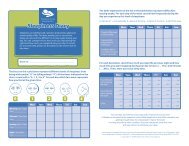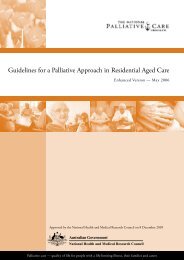Dysphagia - Halton Region
Dysphagia - Halton Region
Dysphagia - Halton Region
You also want an ePaper? Increase the reach of your titles
YUMPU automatically turns print PDFs into web optimized ePapers that Google loves.
<strong>Dysphagia</strong><br />
Oral Health Care Tips<br />
for<br />
Individuals That Have Difficulty Swallowing<br />
August /08
Mission Statement<br />
Together with the <strong>Halton</strong> community,<br />
the Health Department works to achieve the best<br />
possible health for all.<br />
2
• Swallowing difficulty<br />
<strong>Dysphagia</strong> Defined<br />
• Not a disease but a series of symptoms<br />
• 3 types – oral, pharyngeal, esophageal<br />
• 1 in 10 people over the age of 65 have a<br />
swallowing problem<br />
Ontario Heart and Stroke Foundation 2003<br />
3
Causes of <strong>Dysphagia</strong><br />
• Stroke<br />
• Spinal Cord Injury<br />
• Cerebral Palsy<br />
• Parkinson’s Disease<br />
• Amyotrophic Lateral<br />
Sclerosis (ALS)<br />
• Multiple Sclerosis(MS)<br />
• Muscular Dystrophy<br />
• Huntington’s Disease<br />
• Myasthenia Gravis<br />
• Alzheimer’s Disease<br />
• Tumours of the head and<br />
neck<br />
• Injuries to head and neck<br />
• Diabetes<br />
• Arthritis<br />
• Scleroderma<br />
• Chemotherapy<br />
• Anatomical abnormalities<br />
• Drug induced dry mouth<br />
4
Tongue<br />
Oral/Facial Implications<br />
• Can not control food during chewing<br />
• Can not push food from front to back of mouth<br />
Facial muscles:<br />
• Pocketing of food<br />
• Cannot close lips<br />
Sensation Loss:<br />
• Cannot feel the food in the mouth<br />
5
Three Health Complications of<br />
• Malnutrition<br />
• Dehydration<br />
• Aspiration pneumonia<br />
<strong>Dysphagia</strong><br />
6
<strong>Dysphagia</strong> and Stroke<br />
• Level of dysphagia<br />
depends on the intensity of<br />
the stroke approx.½ of<br />
individuals will recover<br />
• Early detection of<br />
dysphagia improves the<br />
outcomes- lowers the<br />
mortality and pneumonia<br />
rates<br />
7
Risk Factors for Individuals with<br />
<strong>Dysphagia</strong> in Predicting Aspiration<br />
Pneumonia<br />
• Dependent for feeding<br />
• Multiple medical diagnosis<br />
• Current smoker<br />
• Tube fed<br />
• Dependent for oral care<br />
• Number of decayed teeth<br />
• Number of medications<br />
Langmore 2003<br />
8
Bacterial Pneumonias are Most<br />
Common in Institutionalized<br />
Individuals Because of:<br />
• Food, secretions, stomach contents<br />
• Sinus infections<br />
• Dental decay and periodontal disease, from dental<br />
plaque<br />
Langmore 2003<br />
9
Impaired Resistance to Bacteria<br />
Due to <strong>Dysphagia</strong><br />
Normal defense mechanisms don’t work<br />
• Coughing is impaired by intubations or neuro-muscular<br />
problems such as stroke<br />
• Immune response is compromised (client is run down<br />
from illness )<br />
10
Development of Pneumonia<br />
• Pharynx becomes colonized with bacteria that<br />
don’t belong there<br />
• Aspirates large volumes of bacteria into lungs<br />
• Local defense mechanism in lungs are<br />
compromised and cannot resist infection<br />
11
Tube Feeding as an Alternative<br />
• Results in a high incidence of aspiration<br />
pneumonia<br />
• Causes poor esophageal motility<br />
• Causes regurgitation of colonized bacteria in the<br />
oral cavity<br />
• Due to the lack of saliva there is no “buffering<br />
agent” to reduce bacteria<br />
• The individual that is dependant on a caregiver is<br />
most at risk of pneumonia<br />
Marik- Aspiration Pneumonia and Dysphasia in the Elderly 2003<br />
12
Silent Aspiration<br />
• 40-71% of individuals who aspirate chronically, do so<br />
silently (do not cough or show signs of distress)<br />
• Silent aspiration is due to a reduced sensation to the<br />
laryngeal and pharyngeal regions.<br />
13
Best Practice for Oral Care<br />
• Ontario Heart and Stroke<br />
(2002)<br />
• Langmore (2003)<br />
• <strong>Region</strong> of <strong>Halton</strong> (2007 )<br />
14
Oral Health Assessment<br />
for the Individual with <strong>Dysphagia</strong><br />
15
Oral Health Assessment Tool<br />
Validated<br />
16
Oral Care Plan<br />
Validated<br />
Oral Care Plan should be updated as<br />
Medical, Physical, and Cognitive functions change<br />
17
Oral Care Planning for Natural Teeth<br />
and<br />
Dentures<br />
Customize care for each<br />
individual:<br />
• Bed brushing<br />
• In a Gerri –chair or<br />
wheelchair<br />
• An activity in bathroom<br />
sitting on walker<br />
18
Care Planning Assessment<br />
• Individuals oral status should be<br />
assessed<br />
• Their ability to brush their own<br />
teeth may be limited from a<br />
stroke, traumatic head injury, etc.<br />
• Check for food pocketing areas<br />
• Use speech pathologist’s notes<br />
for severity of <strong>Dysphagia</strong><br />
• Establish care plan<br />
19
Oral Care Positioning<br />
• Sitting or bed position<br />
should be at 90 degrees<br />
• Head slightly forward<br />
• Chin tucked down<br />
• Follow directions of<br />
speech pathologist when<br />
available<br />
20
Pocketing of Food<br />
• Remove debris with 4x4<br />
gauze or j-cloth that has<br />
been lightly moistened<br />
with warm water<br />
• Write down areas of<br />
food pocketing on care<br />
plan<br />
21
Daily Care Supplies<br />
Natural Teeth<br />
• Hand towel - disposable cloth<br />
– 4x4 gauze<br />
• Non-alcohol fluoridated mouth<br />
wash, Perivex or water<br />
• NO toothpaste to be used<br />
• 2 toothbrushes (large handle)<br />
22
Techniques for Providing Oral Care<br />
for Natural Teeth<br />
• Lightly moisten brush and<br />
j-cloth or gauze<br />
• Remove debris with moist<br />
cloth or gauze then brush<br />
teeth<br />
• Continue to use cloth or<br />
gauze to “mop” any saliva<br />
or debris while brushing<br />
teeth<br />
23
Denture Concerns and Care<br />
• Bacteria on dentures can be inhaled<br />
by an individual with <strong>Dysphagia</strong><br />
• Decreased oral muscle function from<br />
<strong>Dysphagia</strong> puts a person at risk of<br />
swallowing their denture<br />
• Dentures must be removed when<br />
sleeping to prevent aspiration<br />
24
Skill Building<br />
• Take your time<br />
• Eliminate noise and<br />
distraction<br />
• Ensure upright patient posture<br />
• Use mop and go technique<br />
25
For more information call<br />
<strong>Halton</strong> <strong>Region</strong> Health Department at<br />
905-825-6000<br />
Toll free: 1-866-4HALTON (1-866-442-5866)<br />
TTY 905-827-9833<br />
www.halton.on.ca<br />
26


